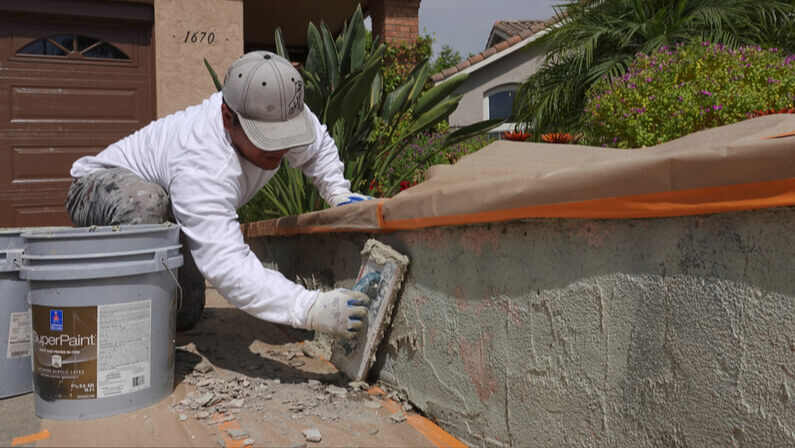Stucco Remediation – Why Stucco Repair Is Important
When moisture seeps into your stucco walls, it can eat away at the structure of your home. A good way to prevent this is to hire a professional who offers stucco remediation.
Loose stucco often bulges and feels spongey to the touch. Tap lightly with a wood or acrylic hammer; hollow spots will sound hollow, while intact areas will respond to the sound with a solid response.

Stucco is a highly durable material, but it needs regular maintenance to avoid excessive water penetration. Excessive moisture in a stucco wall can cause salt efflorescence, staining, and biological growth that damage the substrate. It can also cause water to move between the surface of the stucco and its interior core structure, soaking insulation and causing mold and mildew.
Moisture intrusion in a stucco wall can be caused by faulty construction, improper flashing, and inadequate drainage. Roofs need adequate overhangs to help protect walls from the rain, while roof rakes and flashings should have kick-outs for drainage. Windows and doors need pan flashing at sills and Z-flashing with end dams at heads.
Many homeowners overlook problems with their stucco, especially small cracks that are difficult to see and can go unnoticed until the wall is significantly damaged. Doing a thorough walkaround of your home’s exterior walls at least twice a year is important. Look for cracks and chips that can be repaired before they become major problems.
Missing chunks of stucco are another indication that the underlying stucco is compromised. Moisture tests can help reveal the extent of the problem and how extensive the damage is.
A reputable contractor should consider several factors when quoting for stucco repair. Inspection costs, moisture meter readings, labor to remove damaged stucco, new weather barriers and flashing, paint and tools, scaffolding, ladder, and eye protection are all factors in the cost of a stucco repair project.
Once you know how much a stucco repair will cost, the first step is to fix any underlying issues contributing to the water damage. A burst pipe, a leaking air conditioning unit, or a rotted ledger that supports the deck or balcony may be the source of the problem. Fix the underlying issue before repairing the stucco, or you must do it again. An IICRC-certified water damage remediation expert can advise you about the best course of action for your specific situation.
Mold and mildew are other common issues that can impact the look of a stucco surface. The good news is that getting rid of these stains with some elbow grease and the right cleaning materials is not hard. Mold and mildew typically appear as black spots or streaks on stucco walls, though algae can also stain green material. In either case, these growths are a sign of excessive moisture and should be addressed immediately to prevent further damage to the stucco.
Mold, mildew, and other stains will cause the stucco to lose its aesthetic appeal and may lead to damage in the future. Stucco is one of the oldest and most well-beloved building materials used today, but it requires regular maintenance to keep it looking its best. The best way to keep stains and discoloration at bay is to wash the stucco regularly, especially during rainy weather when dirt is most likely to accumulate on the walls. In addition, homeowners should keep an eye out for cracks and chips in the stucco exterior.
While some homeowners will try to cover up stains independently, this is usually not a good idea. Painting over a stain will not only make the problem worse, but it may also mask any signs of larger repair issues.
The most effective way to remove stains from stucco is with a pressure washer. However, homeowners should be aware that the water temperature and the amount of pressure used will affect the results. It’s important to start low and gradually increase the pressure as needed, as too much pressure can strip away stucco. Using a bristle brush with the pressure washer is also a good idea, as this will help scrub the wall.
Removing any organic material near the walls is a good idea, as these will provide the perfect environment for mold to grow. In addition, homeowners should rinse the sidewalks surrounding their homes regularly, as these can fuel mold growth on the stucco.
Stucco can be a beautiful addition to your home. It’s also a great way to protect your walls from moisture damage. However, if your stucco isn’t applied properly, it can quickly become damaged. Luckily, there are some things you can do to keep your stucco looking like new, including patching shallow cracks.
It would help if you first cleaned the area to patch small holes and shallow cracks in your stucco. You can use a wire-bristled brush or putty knife to remove loose debris. Once cleaned, apply a premixed stucco patching material to the cracked areas. A good thickness for the patch is about 1/2 inch. You may need to add a second coat and sand the patching materials once they are dry.
If you’re repairing a larger area or patching a larger hole in your stucco, you must prepare the surface. This includes pulling back the old metal lath on the non-damaged part of the wall and then applying a new piece nailed to the existing piece. It’s important that the new lath goes in front of the old tar paper at the top and behind it on the bottom (so if moisture gets inside, it will run out and away from the wood).
You can start patching your stucco once the new lath is nailed into place. This is where the skill level comes in and why most homeowners don’t recommend trying to do this alone. It’s better to have a professional take care of it since this type of repair requires a lot of experience.
You’ll also need a few tools to patch your stucco, such as a hawk, which is used for holding the cement mix in one hand and spreading it on the wall with a trowel in the other. You’ll also need a margin trowel, which is useful for placing the cement in tight areas.
While you can do some simple patching projects independently, other types of damage will require more expertise and specialty tools. Hiring a professional is best if you need help getting a good finish or your stucco looks unnatural.
Hiring a contractor with a good reputation is one of the most important aspects of stucco repair. A reputation is built on the quality of work a company performs, the integrity with which they treat their clients, and the level of customer service they provide.
A contractor with a solid reputation will have a strong following in the community and a proven track record in their field. They can offer references from past clients that can attest to the quality of their work and their satisfaction from working with the contractor. A solid reputation indicates that you can trust the contractor to complete the project on time and within budget.
If you have a damaged section of your stucco exterior, it is crucial to contact a professional as soon as possible. If left untreated, small cracks and voids in the stucco can expand and cause severe damage to your home. This is because the moisture that seeps in through these holes can damage and destroy the inside of your walls.
To avoid this, it is important to do a basic stucco inspection. To do this, walk outside your home and note any areas where the stucco is cracking or bulging. If there are several locations where this is occurring, it may be a sign of an underlying problem that requires remediation.
This underlying issue may be due to the structure of your house or even the way that it was initially installed. Remediation will involve tearing down the existing stucco and rebuilding it with new, more durable materials. This process is usually much more involved than a simple repair and often takes longer.
Choosing a local contractor for your area is also a good idea. This can help speed up the repair process because they will better understand the threats that your stucco faces in your specific climate. For example, they will know whether your area has a higher-than-average amount of moisture in the soil or if any particular insects are known to be problematic for stucco.

